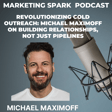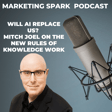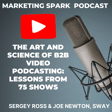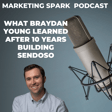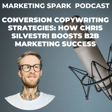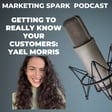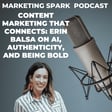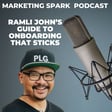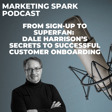Book Announcement: 'Marketing Spark'
00:00:08
Speaker
Before we jump into today's podcast, here are a few announcements. First, the second edition of my book, Marketing Spark, has been published. It delivers strategic and tactical advice and tools to craft compelling stories that resonate with customers. It's a book for entrepreneurs rather than marketers.
00:00:30
Speaker
Through practical advice and real-world examples, Marketing Spark is a comprehensive guide to the art of storytelling. Of course, you can find it on Amazon.com.
Free Workshop on Brand Positioning
00:00:41
Speaker
Second, I'm doing a free virtual workshop on November 24th, which coincides with US Thanksgiving, on improving your brand positioning and messaging.
00:00:52
Speaker
It's interactive and you'll walk away with inspiration and some ideas on attracting and engaging more customers. The link is in the show notes.
Introduction of Pedro Cortez
00:01:02
Speaker
Speaking of positioning and messaging, today's podcast guest is Pedro Cortez, who helps SaaS companies turn more visitors into customers with better messaging and positioning. That's his tagline. I love talking about brand positioning and messaging and gravitate to people who share my passion for what I see as a crucial business pillar.
00:01:24
Speaker
My conversation with Pedro has a different tone. In some ways, it felt like a mini debate or a respectful discussion. As much as I interviewed Pedro about what he does and how he works, I also challenged his thoughts and approaches, particularly around the impact of his work. Part of the problem with positioning and messaging is it's not easy to measure ROI. You can't point to your work and confidently say,
00:01:52
Speaker
This is the reason for better results. Better positioning and messaging matter, but they're one part of a multilayered marketing mix. Now, I enjoyed the conversation with Pedro because it's healthy to challenge other people's views of the world and share different perspectives. I hope you enjoyed the conversation.
Pedro's Approach to Brand Positioning
00:02:13
Speaker
Welcome to Marketing Spark. Thanks for having me. I'll just want to try to make this podcast set episode as valuable as it can be. So let's do it. As we talked about before I hit the record button, I spend a lot of time talking about brand positioning, probably too much time because I think it's so important. It's one of the pillars for SaaS marketing, sales, HR, raising capital across the board. So I'm excited to talk to someone who's obviously a kindred spirit, who spends a lot of time thinking about this and writing about this.
00:02:43
Speaker
Maybe we can start a conversation by having you share your background and how you got started in the world of SaaS marketing and brand positioning.
From Designer to Messaging Expert
00:02:52
Speaker
good. On my end, it was a little bit of a different path, I would say. I actually started off as a designer because I always had this interest. I would look at big companies. And at the time, this was 70 years ago, more or less. And at the time, there weren't that many guidelines on how to design apps. There weren't that many design systems in the first place. And there weren't many guidelines on how to design an app in order to make more money.
00:03:15
Speaker
the revenue side of things on how you can keep users longer and so on. People are just, it was a guessing game and now it's a little bit different.
Common SaaS Messaging Mistakes
00:03:22
Speaker
So there's proper roles for it and tools and so on. So it's a little bit different. And at the time I was looking at what big companies were doing and companies with a lot of users and without having a process with a lot of users and so on were doing.
00:03:34
Speaker
And I felt there was a lot of things missing. I'm a big geek for behavioral psychology and why people buy and so on. So I looked at that and say, looks like this breaks every rule ever. So I thought I could, let's say in the young innocence, just make it better. And I started publishing like a few designs around it, how would redesign this app and that app and so on.
00:03:56
Speaker
And because I used to draw when I was a kid, I used to spend all my hours drawing. I could just look at something and recreate it very easily, even though I haven't used the Figma and so on. So I got it to speed really fast. And I started doing a few projects. I've done a few apps with lots of users. I've worked with a few agencies here in Portugal and a few clients and so on. But then I realized what I actually liked wasn't the
Identifying Positioning Problems
00:04:20
Speaker
was optimizing for more sales. That was the part that I like geeking out on. And then I eventually moved to landing pages because I just thought it was like a medium that was easier to tweak. It would be like more of a B2B aspect because apps are mostly B2C or the most common, the ones with the most users.
00:04:38
Speaker
And then less slowly involved involving to me designing landing pages to just writing the copy and so on. And I just noticed over time, as I was geeking out on copywriting, that the way I think is just it's like a very natural way for a copywriter to think is if there was a type of person that I was born to do, it just felt I was born to do it, let's say. And even though that kind of sounds cheesy. One of the things that
00:05:01
Speaker
fascinates and puzzles me at the same time is how the positioning and messaging for many SaaS companies, including those with great products, is mediocre, if not terrible. You visit their website, you look at the homepage, it's confusing, incoherent. There's a lot of industry vernacular. They're talking a language that is not designed for customers.
Unrecognized Messaging Issues in SaaS
00:05:31
Speaker
question I ask, and I'm going to ask you, is why do so many SaaS companies struggle with positioning and messaging given that it's so important these days to tell a clear and compelling story? How come they don't recognize that their positioning and messaging isn't working or is completely off? And what are the signs that a company has a positioning problem?
00:05:57
Speaker
The reason why I think it's like a lot of companies don't do this properly is maybe for a couple reasons.
00:06:05
Speaker
Probably one of the biggest reasons that they look up to bigger companies and they look at what they're doing and they probably think copying them is a good idea even though they have a lot of brand awareness so they can afford to just not be as clear. It's never a good idea to not make your messaging clear but they can afford to get away with it because people have some awareness of what they do before they even click on the page. So that's one thing. The second thing is
00:06:28
Speaker
Regardless if the founder is technical or not, I think most SaaS founders are like product people. So they like kicking out on the products. They like kicking out on the problems they're solving. They like kicking out on the features they're building, even though maybe not that many people want those features. And it's like they speak their own language. It's not something that is going to be natural to them. It's almost like charisma.
00:06:49
Speaker
That is something that you have to learn how to be well spoken, you have to learn how to communicate with people, you have to learn how to understand their feelings and so on. That is something that you learn over time and that is something as a product person
Improving Conversion Rates with Messaging
00:07:02
Speaker
is like totally the opposite of what you're doing every day. So it's normal that when they try to write something, when they try to explain themselves, they just sound like robots when they try to write something.
00:07:12
Speaker
But do you think they run into the emperor has no clothes problem is that they operate with this positioning and messaging and everyone pats them on the back and says, Oh my God, you're marketing and you're messaging your positioning are so clear. It's wonderful. I love what you guys are doing. But meanwhile, what they have is actually cutting them off at the knees because
00:07:35
Speaker
they're operating with position and messaging that's not resonating, that doesn't have the impact that reflects the value and the utility of the product. Why don't they get that perspective? Why doesn't someone within the marketing or sales or product development team turn to the VP marketing or the CEO and go, when I look at that landscape,
Clear Messaging Before Demos
00:07:58
Speaker
our messaging doesn't work as well. We need to fix it. It needs to be this way. Why doesn't that happen? I think the real answer is probably like a little bit of a lack of self-awareness is denying the actual problem because it feels like they want to sound smart with their marketing or they are looking for the validation of maybe the decision maker or the way that the team wants the product to be perceived rather how everyone else wants the
00:08:25
Speaker
the product to be perceived. And then those things tend to happen, right? They write the pages for other people on the team or how they think they want to do it or making them feel smarter rather than what the customer wants to hear. Because it's pretty hard to do that. That is like the easy way out to just figure out what is a funny way to do this or
Signs of a Messaging Overhaul Needed
00:08:44
Speaker
what is the stereotypical way of creating a website and making it sound like very grand and very like with a lot of buzzwords.
00:08:52
Speaker
all that stuff. I think they just have the wrong reference of what it's a good or about landing page. Given your background in design and landing pages and obviously copy that converts
00:09:06
Speaker
What's your take on the signs that positioning and messaging aren't working? What are the signals that a company would get? Maybe they recognize them or not that they need a different story, something that's going to resonate more, something that's going to drive conversions. Because I think a lot of companies struggle with the idea they don't know what they don't know. They
Ignoring Messaging Indicators
00:09:30
Speaker
don't recognize that they're
00:09:31
Speaker
The positioning slash messaging isn't working. So from when you're working with clients or even when you're communicating via LinkedIn and the other ways that you do marketing, what are the things that you point to and say, these are the signals that your position and messaging are ineffective. So if they had like.
00:09:51
Speaker
really good mental reference of what a good and bad landing page would look like. They could tell right away, but that's not really the case. Otherwise they wouldn't make the mistake. So I think the sign that every person can tell right away, but maybe they don't understand where it comes from, or is like the underlying reason why that happens is let's say if you sell a product through a demo,
Pedro's Messaging Framework
00:10:12
Speaker
And you have all these weird questions in the demo, right? So when they get to the demo, they barely know anything about the products. They don't know any reasons why you're better. Maybe they come up to the demo with the completely wrong expectation, right? So your product does this thing, and they think it does something else.
00:10:29
Speaker
Even if they're more or less related, it could be totally something that is different enough to where you couldn't sell them on that. So those are typically signs that they're just not clear on what you do, but they booked anyway because their problem was so urgent and so big that they had to fix it. So they booked anyway. And that's a very small percentage of the amount of people they couldn't be converting. So let's say out of every 10 people, they're probably converting one or two. The problem is so big.
00:10:56
Speaker
that they book the call anyways, regardless if they know what their product does or not. So that's one layer. The other layer is, let's do the demo again, because normally you get more feedback on their reactions and so on. Let's say you're showing them a feature. You're showcasing some sort of feature based on what they ask. And they're blown away. They're like, I didn't know you could do this. This is way better than what we're using, and so on. So it's like the aha moments.
00:11:23
Speaker
of why the product is so good only happens either after they see it in a demo or once they try it. If that's the case, then it's like a sure sign that you're losing money by just not improving your messaging and your positioning. Because people should have, even if it's a smaller version of that aha moment, they need to have that. It needs to be clear right away the three pillars that I usually talk about. What is the result that you provide?
00:11:50
Speaker
Why are you better than what I'm using right now? Otherwise, you'll never overcome that resistance of switching over. And what is the risk? How long would it take to set up? Or how long would it take to train my team? And so on. If they don't understand
When Clients Seek Messaging Help
00:12:02
Speaker
these three things at the same time, then you're never going to be as optimized as you should be. Because otherwise, there's just going to be people that are never going to convert. Usually with my clients,
00:12:13
Speaker
Even if their page is okay and they're converting, there's always like this percentage of people that they could never convert.
00:12:21
Speaker
because they're more skeptical than everyone else. Normally, these are more enterprise leads or leads that they want to target if they want to go up markets. They have tried more tools. They're more skeptical to whatever the website claims. And they are probably experimenting with several tools all the time. So their mind is clearly comparing all the time at everything you're saying. So they're much harder to convert, but they pay way more.
00:12:45
Speaker
I would argue in theory that what you say makes sense if I'm a salesperson
Resolving Messaging Issues
00:12:52
Speaker
or a BDR and I'm doing a demo or a presentation and I say something that the light bulbs go on immediately or a lot of what I'm saying isn't resonating and people are there silence and people are confused and they're asking questions. Those are amazing signals that
00:13:11
Speaker
Should relay back to the marketing team and the product team, but often I don't think that happens and I don't think there are. I'm just curious about the other signals that a company can receive from prospects and customers about their messaging, because I think. Like my experience, a lot of them operate in ignorance is that they're just doing what they're doing there. They don't know what they don't know and that there's just not.
00:13:39
Speaker
enough blatant shots across the bow that will say to a company, your positioning, your messaging sucks and you did change it. A lot of them operate
Clarifying the Sales Process
00:13:49
Speaker
in ignorant bliss and they don't know any better. And I just, that's one of the challenges that I have is as a somebody who spends a lot of time on positioning is getting people to recognize that what they have is a pain, a big pain that needs to be solved ASAP. Any thoughts on that?
00:14:08
Speaker
When you say big pains, are you talking about the people you're helping or like the customers looking at the website? The people that I'm helping because...
00:14:16
Speaker
When companies, okay, let me take a step back here. A lot of companies will look at conversion rates, for example, and if they're way below industry benchmarks, they know they have a problem. If they're not getting inbound, the pipeline isn't being filled, sales aren't happening, then that's the reason for panic in a lot of companies, and they'll do a complete tactical overhaul. Positioning seems to be a different creature because the signals aren't as blatant. They're there, but they're not on a dashboard that says, our position is not working, we need to change it.
00:14:46
Speaker
maybe questions during a sales call will provide some indications. What I'm asking from your perspective is that what are those blatant signals? What should the head of marketing or a CEO be looking at that tells them our positioning's not working? Because they could operate
Long-term Positioning Strategies
00:15:04
Speaker
without knowing what they need to know for a long time. Yeah, in my case, when I work with clients, they talk to me at a point where they're like,
00:15:13
Speaker
they clearly see all these signs and demo calls and so on where they're like, yes, once people, if only I could get more demos, if only I could get more signups, I know that I could close a huge percentage of these people. So they come with me without pain already. That's the kind of the clients that I choose to work with in a first place that kind of fixes that problem on my ends. But I like to look at it in two different ways, let's say. So let's say if you want to fix the messaging, it's more like, how do I
00:15:41
Speaker
explain the product that I already have with the same markets in the best way possible so they look at our offer and it's like the most attractive thing that it could be so we can just get more people to buy it. Usually a sign for this is if you look at your numbers and look at how many people are getting into the website, how many signups are you getting, how many people are turning into customers,
00:16:02
Speaker
how many are renewing, and so on and so forth. If you look at your numbers and you figure out what is the biggest bottleneck at the moment, and the only way that you could grow your business or the fastest way to grow the business is to just convert more people out of the ones you're already getting onto the website.
00:16:17
Speaker
it's yet another signal that you need to fix it. Because otherwise, tweaking other numbers before you do that is just not going to be as effective. So if you have your numbers laid out like that, it just becomes more evident. The second area of this is the positioning parts. It's usually a little bit broader. The way I like to look at it is if they want to go for either different markets or if they want to go, let's say they're in a red ocean, they want to create a new category and so on, that is something that is
00:16:46
Speaker
a little bit more long
Recognizing Messaging Issues
00:16:47
Speaker
-term, a little bit more complex. And it's almost, it's very hard to sell them on that unless they can see it because it's like untapped potential. So it's like a market they haven't really experienced much of because they haven't really gone for that market a hundred percent. So that part is a little bit tricky. I like to look at it as separate problems almost depending on the clients.
00:17:08
Speaker
I feel like we're geeking out here and really going deep into the weeds, but that's what this conversation is all about. But I'm going to counter what you said. Do customers come to you, do companies come to you knowing that they have a messaging and positioning problem? What happens in my experience is that they have a conversion problem or they have a MQL problem or a sales problem.
00:17:30
Speaker
marketing is not working, the business isn't doing well. So the first reaction is, I think in many cases, even before the look at the strategic focus, it's to look at the tactical levers that the point, oh, we should spend more money on advertising. Maybe we should go to more conferences. Maybe we should publish more content, given the rise of AI. Maybe we should improve our SEO, but I would suggest that
00:17:54
Speaker
messaging and position are probably pretty low on their radar. It's probably not seen as the cause of their problems, when in fact, it could be one of the missing pillars. My question to you is, why do your customers come to you? Do they come to you because they recognize, oh, Petro, I have a messaging and positioning problem. If you could only fix that, my marketing would be better. Or are they coming to you
Stages of Messaging Awareness
00:18:16
Speaker
saying, my website's not working, conversions are down, bounce rates are up, and I can't figure out what's going on. Why do they come to you?
00:18:23
Speaker
Usually, when clients come to me, they're a lot more aware of what the problem is and the answers of, I know that things aren't clear. I'm not sure which angle would work best, but I'm confident that this is one of the biggest opportunities I have. Do they know they have a position in a messaging problem? Is that what they come to you and say, I have a position in a messaging problem and you have to help me? Or is it something else that they say, but what they really mean is I have a position in a messaging problem.
00:18:49
Speaker
They say that, but it's for two reasons. One, because all the content that I create, which is the thing that gets me all the clients, is directly related to, is essentially only problems that the exact clients I want would have. So only them resonate with that type of content and it kind of filters, it filters
00:19:14
Speaker
some of the people out because I like to work with people that are already aware of what the problem is because I don't want to sell them on it. So here's what I mean. Someone could come to me and part of my job, depending on how deep you want to get into this could be, let's say I want to make more money. There's like a, let's say it's like almost like a timeline because they also take some time to realize this if they're doing it by themselves. Let's say
Communicating Importance of Messaging
00:19:43
Speaker
is I want to make more money. Okay.
00:19:45
Speaker
I want to make more money, it means I need more leads. And if I need more leads, it means I need to improve my marketing. But how do we improve my marketing? Which area? OK, it looks like it's probably my website. OK, why is my website? It's probably messaging, right? So you see all these phases that they have to transition through. You could be the medium on the call. Like if they see you as an expert, you can transition from if you want to make more money, this is your opportunity. And you go through all the stages.
00:20:10
Speaker
But they have to be really receptive to it. I usually don't go back more than one or two stages because I like someone to be really sold on what we're doing because it's just like the type of client relationship that I want to have. So in my case, I do it on purpose. I only want to talk to people that just do that. I agree. And I think that.
00:20:32
Speaker
Correlating the symptom with the problem is a great way to educate companies on what's really happening. So if your website's not converting, for example, you and I should be doing marketing. Say your website's not converting, probably one of the reasons is your messaging's not working and you probably don't have good positioning. Okay, great. Okay, your advertisements
Websites as Salespeople
00:20:54
Speaker
aren't converting because your landing pages
00:20:57
Speaker
don't work, you've probably got messaging and positioning problem. Is that the formula that you're using to communicate to your ICPs? It's similar to that, usually on the LinkedIn side of things, like when I actually post stuff. One thing that tends to work really well is if I frame it almost like a sales call, because then everyone understands this. Because if you think of your website as a salesperson,
00:21:23
Speaker
It's pretty obvious that if that salesperson doesn't explain the product properly, or most importantly, doesn't answer the objections, he closes like zero deals. So if I was a salesperson selling software products, even if I show the product perfectly, and at the end, you ask me a bunch of questions and I can't answer them.
00:21:39
Speaker
They get defensive, they assume things. If I don't talk about the setup, they assume I'm not going to help them or it's going to take a long time. So you can kill the deal with, they can be turned off really easily, right? Same thing with your website. If you look at it as a bunch of questions that are not really answering, then people start realizing, yeah, people have this question about my website, my setup time.
00:22:00
Speaker
People assume all the time that the setup is long, but it's not. So that is a question that is preventing them from lying. So my content, what it does is it builds the bridge that I don't want to build on. I want more leads all the way up to I have a messaging problem. My content does that. I go from messaging problem to which part of the website are we going to tweak and so on, because I don't want to bother with the rest when I'm talking with someone. Because that's how you make the sale
Measuring Messaging Success
00:22:26
Speaker
call really long or you just talk with people that are not serious.
00:22:29
Speaker
So we spent a lot of time looking at the signals of bad positioning and messaging. Why don't we attack this from a different angle and look at one of the biggest challenges when it comes to position messaging is quantifying the success of the work that you and I do.
00:22:50
Speaker
and being able to measure and assess the impact. Because if you look at the deliverables of a position in a messaging and exercise, you get your value propositions and your brand positioning statement, and you identify the key benefits, the biggest value that you deliver. We identify what makes a company different. We'll update the messaging, the website, that kind of stuff. But a client will turn and say,
00:23:15
Speaker
How's that going to impact my business right now? Because we live in a very show me, instant gratification world. So when you're working with your clients and they're talking to you about the work that you do and its effectiveness, how do you demonstrate ROI? How do you say to them, okay, here's how I quantify the success of the work we've done together. What are those KPIs? If we can actually use KPIs for positioning and messaging.
00:23:44
Speaker
I think those are probably two
Tracking Messaging Effectiveness
00:23:45
Speaker
questions. It's more like, how do I measure results and which things am I going to measure? The first thing that I always like to say to any clients or any people that I'm speaking with on a call is that tracking is like very far from actually being perfect.
00:24:00
Speaker
There are a lot of things that we can attribute. The buyer's journey is pretty complex. They might see an ad. They come back to the home page where they convert from the pricing, whatever it is. They convert from a new computer. Or someone else in the team refers. It's because there are multiple people involved in the decision before they even book a demo.
00:24:17
Speaker
all the stuff. So I say that it's never really perfect to every prospect. So what I like to do is I like to look at what is the information that we can use in order to try to make the best assessments of whether this is working or not, depending on what the client has. So it depends on how much traffic they get, where does the traffic come from. So for example, if you get a ton of traffic, but all of it comes from the blog and very few traffic actually goes to the marketing pages and makes it a little bit messy, or if you get all the traffic from referrals and so on.
00:24:47
Speaker
That makes it a little bit tricky, but the main ways that I track it is either a baseline test, meaning that you'd have to know more or less how many trials or demos are you getting per month and what is the average revenue you get per customer. And it has been consistent for the last few months. The reason
Revenue as Messaging Metric
00:25:06
Speaker
why this works for me is because people only reach out to me once they really feel that they're screwed, that only I can fix the messaging because they tried it before and they don't know how to do it.
00:25:17
Speaker
So it means that their results have been pretty consistent. So therefore, if I make a change, we can see the results. So we do that if they don't have enough traffic for an A-B test. Otherwise, we just do an A-B test. That would be ideal. Sometimes with clients, we have some pages where we can do a straight A-B test and other ones we have to do a baseline. And in terms of the KPIs that I'm looking for, I'm very biased towards revenue.
00:25:42
Speaker
Right? So all I want the clients, all I want for the clients for them to get an instantly good ROI. So let's say you have 10,000 visitors and you have 500 signups or whatever it is. If I make the signups go down, but I make more revenue,
00:25:58
Speaker
I don't care, I'll do it anyway. Because I could explain it in a cheesy way that I could get more signups and it would be like a worse quality and it would be even harder to score them and so on. So I was just going to be biased towards revenue and probably even increasing the revenue per customer. So I'll give you a
Complexities of Measuring ROI
00:26:15
Speaker
random example. Let's say, I think the most common results is to get a more or less an equal increase per page. So let's say I redo this landing page, right? You get a 50% increase in conversion.
00:26:28
Speaker
Revenue per customer is about the same, a little bit higher, because they came with more context before they actually tried the products. So therefore, they were a little bit more likely to buy. So let's say that is the average result. But I've had plenty of clients where we got a 10% increase in signups, which is it's weak, even if it was just from one page, given the traffic that client had. But they got a 40% increase in revenue from all the signups that they got.
00:26:59
Speaker
because it was an audience that they couldn't sell to before because they were too skeptical, right? So I'm always biased towards revenue. If we have a higher bounce rates or if they spend less time on the page or if they don't scroll until the ends, I don't really care as long as we make more money. Yeah. I mean, I like revenue as a North star. I guess the question I would ask is whether you can directly correlate better messaging and positioning with revenue because obviously
00:27:29
Speaker
What your work is one part of the mix. It's at the same time, the company based on the position and messaging they have could spend more time on social media. They could spend more time or more money on advertising. They could be doing more cold outreach. So there's lots of different things that they could be doing that are different that support the work that you've done, but it's, but it,
00:27:54
Speaker
But if they didn't do all that stuff, maybe your work just wouldn't be noticed because they wouldn't be putting the spotlight on it. So it's
Client Awareness of Messaging Impact
00:28:04
Speaker
a tricky thing to say, I created a better position in messaging and revenue went up and it's all because of my work. You're taking credit for all of that. And I think that's
00:28:17
Speaker
I feel that it feels like a reach. It really feels like because I just don't think one thing moves the needle these days, even if it's much better positioning and messaging.
00:28:25
Speaker
The short answer is directly, you can't really correlate. It's pretty hard. But when I work with clients, and that's why I don't have case studies for all the clients, is because it's not insanely clear that those results came from me. And also because not all of them let you make it public because competitors will look at it and so on. But it's very hard to make it like a direct correlation unless everything is dialed in except for the messaging.
00:28:54
Speaker
which sometimes when they talk to me is because they get desperate because the sales process is dialed in, churn is pretty low. At this point, it's hard to get more traffic because all the keywords they're ranking for is already good or it's hard to increase the marketing budgets before increasing the conversions because otherwise it's not going to be profitable. Therefore, there's only one thing that they can tweak.
00:29:16
Speaker
in order to make revenue go up. There's nothing else they can do. So in those cases, it's very easy to correlate because they have a baseline. They're having converting about the same. There's very little citizenality. So it's very easy to correlate. But I would say in more than 50% of the cases, it's hard to correlate. That is just the honest truth. But at the same time, a good entrepreneur knows that it takes time. And most
Confidence in Messaging Success
00:29:44
Speaker
get indirect results. So in your case, you're creating content on LinkedIn. You could be doing call outreach. You could be going to events. You could be doing all this stuff. But you're doing podcasting, which maybe took you months and months to see the actual results. You just had to trust that it would work. And you're still not exactly sure how many clients you got from podcasting because
00:30:06
Speaker
you might have gotten a referral that then watch your podcast and convert six months later. And they never told you about this, even if you ask, they just forget. So a good entrepreneur also knows that. And that's why I'm very picky with the clients that I work with, because I want them to feel successful. And it's also part of it. Then be a great answer. And I don't mean to push you and be antagonistic here. But I think it's really interesting to look at what we do. And to
00:30:33
Speaker
can talk to people about the impact that it makes. And maybe it's just a thesis that the ultimate KPI for positioning and messaging is confidence. If a company, the CEO, the head of marketing, the head of sales, the head of product, the employees feel like
00:30:53
Speaker
what you've given them, what we've given them is a much more powerful, impactful story that makes it abundantly clear why this company is the obvious choice, that puts the spotlight on the company's strengths and starts to amplify those strengths of the world and starts to position this company as something special, tells a story that reflects the quality of the product. The whole company moves forward in a more confident way, knowing
00:31:23
Speaker
that they're all reading off the same page. They believe it.
Long-term Impact Tracking
00:31:26
Speaker
They can see themselves as being differentiated and that just, it's very subjective. It's a very hard to quantify feeling, but ultimately that could be in the short term. That could be how you and I say to a client, yeah, we've done a great job together and now it's time to move forward. What do you think of that?
00:31:46
Speaker
Yeah, I'm totally happy to answer these questions because even today I'm working with someone in my team to see if we can figure out, is there a better way that we can test things? Is there a better way that we can quantify results because it's not like the.
00:32:00
Speaker
Obviously, the clients are super happy with the story they have and the results they get, and they do see the results, and they are aware of them. But the more aware they are of the results they're getting and how far they've come, if there's a way to make them constantly aware, that would mean that the clients would just come back more often, right? Because it's like the idiotic treadmill, right? You'll get used to having that sort of success.
00:32:24
Speaker
And then you forget about it, right? You forgot what kind of got you there. That was the website. And then they might assume that you have to tweak the website like once a year or they, or.
00:32:35
Speaker
It's like the amount of times that they think about tweaking the website just makes them way more likely to come back to me or to refer me to other people. So the better that I can track this, the more aware they are of the results and the more they'll come back and so on and so forth. So it's more beneficial for everyone. It's just at this point, it's very hard to track. It's like a puzzle. It's a big puzzle. You're picking up on people
Updating Positioning and Messaging
00:32:56
Speaker
coming back to you.
00:32:57
Speaker
One of the things that I talk about a lot when it comes to positioning and messaging, it's not a set it and forget it proposition. You can't, okay, we've done our positioning, now we're good to go. It constantly evolves and changes. What are the signs that
00:33:13
Speaker
a company needs to refresh its position. It needs to tweak it a little bit. Are there things that they can look at and what are the processes that you would suggest that a company go through to make sure that their message, their positioning is still relevant and still resonates?
00:33:29
Speaker
That is the timing for that changes depending on the market you're in. So the way I usually look at it is, let's say you've redone your messaging and now the website is really clear and people understand the offer and so on. But over time, it's not like the messaging is going to become unclear. It's more like, how do people see you compared to other solutions in the markets? And that could be.
00:33:51
Speaker
Sometimes other solutions in their head could be not doing anything at all, hiring someone to do whatever your software does, or just other software that they have available in the market. So when the market evolves and the functionality of other products or other solutions they have also evolve,
00:34:09
Speaker
The way that they look at your product versus every other solution starts to change because other products are becoming better, or their messaging is better, or their pricing is different, and so on. As they add more variables, you need to just
00:34:24
Speaker
Do a slight retouch in your messaging or your positioning so you can always feel like the best solution in the markets. It's like a comparative thing, right? You always want to win the comparison they make in their head of whether or not this is the best solution out there. It just depends on how fast other solutions evolve.
00:34:44
Speaker
Basically, what you're doing is you're monitoring your product and how it's evolving. You're looking at how customers are using it and you're constantly looking at the competition and seeing how they're positioning themselves in the market to make sure that you've got all the right signals so that you can make any moves if necessary.
00:34:59
Speaker
Yeah, exactly, because you have to figure out what's going to be your next move. Are you going to double down? Are we going to double down on just one ICP? Are we going up markets? Are we going to just try to get some more lower ends accounts, like million things that could be done? Right. So I've asked you a
Advice for SaaS Companies
00:35:15
Speaker
lot of hard questions, a lot of tough questions. I've challenged you, which is the whole point of this podcast. I mean, I like a bit of a softball question. What advice would you give us to a SaaS company looking to improve their messaging and positioning, but they're not sure where to start?
00:35:28
Speaker
I think that has a few different pillars in order for them to execute it properly. First is identifying which opportunity to go after, and then is how to actually tweak it. The first problem
00:35:49
Speaker
It's more about, usually the best way to figure out the best opportunity is looking at the pages, looking at your buyer's journey, right? So let's say where the people come from, what sort of expectation they have, what pages did they go through before they made a decision to buy, and based on the amount of traffic that each one gets,
00:36:11
Speaker
at the same time compared to the level of intent it has. For example, if your blog gets a lot of traffic, it doesn't mean you have to tweak it because that's the whole point of it. Your homepage might get a lot of traffic as well, but that doesn't mean that you don't have to tweak the pricing, for example, which is one of the most important ones. It might get less traffic, but it's one of the first things and last things people check before they're ready to buy. You just have to balance out
00:36:37
Speaker
the amount of volume or the amount of people looking at that page versus the intent that he has in the relation to people actually buying. So that's how you find your opportunities. In my case, what I like to do is I like to do short projects, three to five pages, validate it really fast.
00:36:52
Speaker
If you do less than that, it's not really worth it because of the research process that has to be done. And then just get the best results you can get with the minimum least amount of efforts. And then it repeats the process like several sprints a year. That would be the first way of looking at it in order to identify the opportunity. The other way of doing it is of actually executing is changing how you think about the pages themselves. So again, think about it as a sales call.
00:37:20
Speaker
So list out all the concerns that people would have before they buy. List out all the ahamams that people get once they jump on a demo and they see it and they get blown away by it.
00:37:32
Speaker
Think about all the reasons why people switched over from one product to another. Because it's one of the hardest things that you can do is have someone go through the pain of switching from one product to another. So it just means they saw something in your products that just made them overcome their resistance. So you need to pay really good attention to that. So list everything out, all the reasons. You list all the ways you would answer them. And then you start thinking about the layouts of the page.
00:38:02
Speaker
What should each section say? Outline it first. You think about what you want to say before you think about how you want to say it. So first, define really what are the things that have to be on that page versus the things that have to be somewhere else.
00:38:16
Speaker
What is going to go on each section? And only after that, only after you define all that is when you start thinking about headlines and images and so on. Typically, people do that the other way around. So they think about images and design and the headlines and so on. And it's very hard.
00:38:32
Speaker
You almost get writer's block, because the reason you get writer's block is because you're trying to think and filter at the same time. So first, you just do a big-ass brain dump in a Google Doc, and then you filter everything out. And then, essentially, you break it down into one step at a time. First, the structure. What am I going to say? What are the headlines? What is going to be supporting these headlines? What is the order going to be? One
Where to Find More About Pedro Cortez
00:38:57
Speaker
thing at a time, then it's much smoother.
00:39:00
Speaker
Great. Thanks for all the great insight and thanks for the conversation. We covered a lot of ground in a short period of time. Where can people learn more about you and what you do?
00:39:09
Speaker
So people can find my website at Cortez.design. They can find a little bit more information about the services, some of the case studies I have as well. I also have a cheat sheet, which is the landing page formula I use for all the clients. And they also has a tutorial and so on that is available for free. So that's something that they can download if they want. It essentially walks them through all the process of actually doing a homepage or a landing page. And then they can also find me on LinkedIn, which is where I share most of the tips. So stuff that companies do wrong,
00:39:39
Speaker
Tear-on-thumbs of landing pages good or bad, overall tips, client results if they want to geek out on what results they got and why they got those results and so on. Those are the two best places. Thanks again, and thanks to everyone for listening to another episode of Marketing Spark. If you enjoyed the conversation, leave a review. Subscribe via Apple Podcasts, Spotify, or your favorite podcast app, and share via social media.
00:40:03
Speaker
If you'd like to learn more about how I help P2B and SaaS companies as a fractional CMO and my recently launched 90-day marketing sprint service, send an email to mark at markevans.ca or visit marketingspark.co. I'll talk to you next time.


